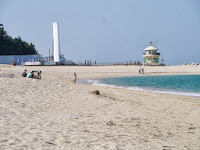Before heading out for my Chuseok holiday, many of Korean friends ask, "Why Gangwon-do? Don't you want to go to Seoul or Busan?"
There are no towering skyscrapers in Gangwon. There is no Fifth Avenue. This isn't the trend-setting glamor of Gangnam or Hongdae. But unlike the overcrowded beaches of Busan, or the endless asphalt of Seoul, Gangwon-do has a unique charm that can only be found in the raw beauty of its land, and the warmth of its people.
When the Chuseok holiday arrived this year, my fellow English teachers and I were gifted a five-day weekend away from work. While the masses headed to popular destinations like Jeju and Busan, my friends and I boarded our Wednesday morning bus for Gangneung, a beach town in the central coast of Gangwon-do. After some mild confusion and a complimentary van ride, we arrived at Gangneung Guesthouse, just a few hundred steps from the cleanest beach I've ever seen, Korean or otherwise.
We followed up a relaxing afternoon in the sand with a feast of seafood stew and beach-side beers - and a celebratory amount of Chuseok fireworks.
Unlike their Busan counterparts, the beaches of Gangwon-do offer space for true relaxation. Gangneung's beaches offer the same crystal blue water, stretching out into the open Pacific, but delightfully lack the swarms of humanity that have taken over Haendae beach in Busan.
 |
| No thanks |
Our rooftop feast continued into the night, sharing pieces of masterly prepared pork belly with friends, and washing it down with cheap, but cold beer. For me, it was a farewell celebration for summer - a time on the calendar where one season ends, and another begins, when we enjoy the flavors, sights, sounds and smells of both in a toast to what the summer was, and what the next few months will be.
Our time in Gangneung had come to end, and it was time to head down the coast of Gangwon-do to our next destination: Samcheok.
Bussing through the mountain highways on our way to Samcheok, the rolling, undisturbed hillsides of evergreens gave me flashbacks to summer mountain drives in Colorado. The beauty of Gangwon-do lies in part to how big it all seems to be, and the vivacity of its colors. Smooth highways cut through valleys and span gorges, but in steady harmony with the surrounding landscape.
We pulled into the much smaller Samcheok bus terminal, eventually found our bearings, and jumped in a taxi headed for Samcheok Beach.
To me, Samcheok seemed to be a secret - a beautifully isolated beach with only a handful of budget hotels dotting it's coast, there was no reason why this place wasn't covered with the swarms of Haeundae. For only about $20 a night, I could look out of an open window in my hotel room, down to an open beach with yet another untouched, blue horizon.
Our little beach-side escape served as our launching point for an afternoon of truly unique exploration. Samcheok has it's beaches, and it's also got its fair share of weird. Undoubtedly one of the strangest attractions in Korea, Haesindang Park is set upon a magnificent coastal cliff, overlooking the Pacific through the frame of seaside pine trees.
And some other stuff.
What the Korean Tourism has tastefully labeled as a collection of "unusual phallic sculptures," was truly a park full of ten-foot tall, absurdly creative interpretations of male genitalia.
This one was a page out of the "of all things, why this?" book.
But, perhaps thankfully, this wasn't just a desperate attempt for tourist publicity. The statues originate from an ancient Korean folk tale, where a young, engaged woman in the nearby fishing village died unexpectedly before her wedding day. Immediately after her death, the fish disappeared from the ocean. The local fisherman were unable to catch anything until one day, after one fisherman relieved himself into the ocean, the fish returned to Samcheok. Ever since then, the locals have proclaimed their appreciation and respect through, well, things like this:
Concluding one of the strangest afternoons I've had in a while, my friends and feasted on another seafood delight for dinner: 희 (more or less pronounced "hweh"). A feast of 희 begins with picking out one of fish swimming around in the tank out front of the restaurant, which then quickly turns into plate after plate of sashimi slices. Raw fish, Korean style, is fresh and enormous.
We were even gifted with a complimentary $70 plate of fish when our dining neighbor, the man just behind us, ended up being completely black-out drunk when his food arrived.
Some things in my life, I believe, will only happen to me while I'm living in Korea. Getting someone else's food because he passed out after ordering it, might be one of those things.
The next day, our last one in Gangwon-do, we set aside for exploring Korea's biggest limestone cave system: Hwanseongul Cave.
The hour-long bus ride up to the cave took us through a valley of country homes, and green, green scenery. The light mist shrouded the mountains around us peacefully, as the limestone hills rose up into the layer of light gray above.
Hwanseongul was an impressive cave, and must definitely a Korean cave. The impressive cathedral-like walls of limestone gave way to enormous chambers - which happened to be lined with colored lighting. Yes, even here, among the underground grottos of Hwanseongul, neon lighting had found a way to show up.
Despite the gaudy attempts to compliment Mother Nature with cheesy electric displays, the halls and subterranean waterways of the cave were brilliant.
Returning to the misty surface, we stepped back into our lives as English teachers, and descended the hillside into reality once again.
Gangwon-do was the breath of fresh air we all needed. It was rejuvenation, adventure, and randomness all rolled into one special place to spend a holiday vacation.
-Thanks to my friend Alex for the wonderful photography

















Awesome trip :)
ReplyDelete